21. For--in either event
(Php 1:20)
I must be the gainer, "For to me," &c.
to live is Christ--whatever life, time, and strength, I have, is
Christ's; Christ is the sole object for which I live
(Ga 2:20).
to die is gain--not the act of dying, but as the Greek
("to have died") expresses, the state after death. Besides the
glorification of Christ by my death, which is my primary object
(Php 1:20),
the change of state caused by death, so far from being a matter of
shame
(Php 1:20)
or loss, as my enemies suppose, will be a positive "gain" to me.
JFB.
The Book of Philippians
Philippians 1:21 - For to me to live is Christ, and to die is gain.
Philippians 4:4 - Rejoice in the Lord always: and again I say, Rejoice.
Philippians in The New Testament - A Brief Overview

Painting of Paul the Apostle by Rembrandt - 1657
Introduction to The Book of Philippians
Brief Summary. Paul had been imprisoned at Rome sends the church at Philippi a love letter of thanks, commending them for their liberal giving. His attitude shows all Christians to rejoice in every situation even suffering, for Jesus Christ is our example and our prize.
Summary of The Book of PhilippiansPurpose. One of the obvious reasons that Paul wrote his letter to the Philippians was to thank them for their generous offering. He also wanted to commend the unselfishness of Epaphroditus, as well as informing them of his love for them, and his own personal condition. He wanted to make them aware that Timothy would soon be visiting them, and that Epaphroditus would be returning to them (Philippians 2:19-20). Paul also warned them that they would be suffering for the gospel of Christ (Philippians 1:29, 30), and that they should be aware and guarded against false doctrines creeping into the church (Philippians 3:1 ff). Paul's joy, and love for them clearly shows through in this letter.
Philippi. The city of Philippi was a Roman colony and the chief city of Macedonia (Acts 16:12). Philippi was originally named after Philip of Macedon. the people that live there were Roman citizens, receiving all the favor of Rome. There were very few Jews in Philippi, and no synagogue with a "place for prayer" by the river (Acts 16). Paul established the church in Philippi while he was on his second missionary journey, just after he had been in Troas and received the "Macedonian call" (Acts 16). The Church of Philippi was the first church to be established in Europe, and it had a reputation of being very generous in their support of Paul's work (2 Corinthians 8; Philippians 4:15-19). a half-century later Polycarp commended the church in Philippi for their devotion.
Authorship. Paul was the author of Philippians, he names himself and his style and personality shows through.
Date. Philippians was written from Rome during Paul's first imprisonment, about 62 AD.
Outline of the Book of Philippians
Jesus Christ is Our Life - Chapter 1
Jesus Christ is Our Example - Chapters 2
Jesus Christ is Our Prize - Chapter 3
Jesus Christ is Our Peace - Chapter 4

The Name Jesus In Ancient Hebrew Text
"Yeshua" in First Century Hebrew Text. This is how the name "Jesus"
would have been written in ancient Hebrew documents. The four letters or
consonants from right to left are Yod, Shin, Vav, Ayin (Y, SH, OO, A).
Jesus is the Greek name for the Hebrew name Joshua or Y'shua which means
"The LORD or Yahweh is Salvation".
Philippians Maps and Resources
Map of the Roman Empire (14 A.D.) - This map reveals the Roman Empire during the time shortly after the birth of Jesus, in 14 AD at the time of the death of Augustus. The order which prevailed in this extensive empire, the good military roads, and the use of Koine Greek as the general language of culture throughout the area were among the factors which multiplied the rapid spread of the Gospel of Jesus Christ. (Color Map)
Map of Paul's First Missionary Journey (48 A.D.) - This map reveals the areas in Asia Minor where Paul visited in his first missionary journey. Around 48 AD, in the springtime, Paul and his companions Barnabas and Mark were sent on a mission from the church in Antioch. This would be the first of Paul's Missionary Journey's. (Color Map)
Map of Paul's Second Missionary Journey (51 A.D.) - This map reveals the areas in Asia and Greece where Paul visited in his second missionary journey. Paul re-visits a couple cities in Asia, one of which was Lystra where he was stoned and left for dead a few years earlier. He later has a vision that leads him over to Greece and Paul and his companions travel and minister in various cities in Greece (Philippi, Thessalonica, Berea, Athens and Corinth. Later Paul returns to Ephesus and finally to Caesarea and Antioch. (Color Map)
Map of Paul's Third Missionary Journey (54 A.D.) - This map reveals the areas in Asia and Greece where Paul visited in his third missionary journey. On Paul's third missionary journey he returned to the cities he had first visited on his first missionary journey. During this time he decided to remain in Ephesus for about 3 years, and this city was the main focus of his activities and an important Christian community (Acts 19). (Color Map)
Map of the New Testament World - This map reveals the "Nations" within the ancient world during the first century A.D., the time of the New Testament. The map includes the areas of Israel, Asia, Greece, and Italy. (Color Map)
Map of New Testament Asia - This map shows the cities within
Asia Minor during the first century A.D., the time of the New
Testament. The map includes the principal cities of Asia
including Tarsus, Ephesus, and Colossae, and provinces like
Galatia and Pamphilia. (Color Map)